No products in the cart.
NEWS
Farming Giant Freshwater Prawn
Why GIANT FRESHWATER PRAWN?
Giant freshwater prawns live in freshwater environments but berried females migrate downstream to brackishwater where the eggs hatch into larvae. The ideal salinity of brackishwater for larvae to survive is 12 ppt. These crustaceans are common in the tropical and sub-tropical waters of the Indo-Pacific region and are reported to grow to a length of 25.5 cm. Based on breeding trials, they take at least six months to mature.
How to culture GIANT FRESHWATER PRAWN?
Broodstock management
Brownish (left) and orange eggs (right) Broodstock are stocked at about 4:1 female-male ratio. Blue- and orange-clawed males are preferred since these males are bigger and are able to mate more efficiently than smaller males.
- Orange eggs of berried females will take about 3 weeks to hatch while grayish or brownish eggs will hatch in 2 to 3 days, usually at midnight to early morning.
Larval rearing
- Larval rearing tanks may be made of fiberglass, polyethylene, or concrete. Water with a salinity of 12 ppt is used and stocking density is 50-100 larvae/L.
- Total standing water volume at any given time to produce 700,000 postlarvae (PL) from 2.5 million stage I larvae is 50 tons excluding water change. Allocate 150 m2 area for the tanks and other hatchery facilities. This is using the lower limit of stocking density at 50 larvae/m2.
- Larvae are fed brine shrimp nauplii, egg custard (solidified egg emulsion), and water fleas, Moina sp.
- Water quality is maintained at pH=7.2-8.5, dissolved oxygen (DO) >3 ppm, temp=28-31°C, ammonia <0.1 ppm.
- The larvae undergo eleven distinct stages of development before they metamorphose to PL in 28-35 days depending on temperature, nutrition, and other factors.
Polyethylene (left) and fiberglass (right) larval rearing tanks. Larval rearing tanks can range from 100 L capacity to several tons, depending on capacity and target production.
Nursery
- Primary nursery rearing phase takes 15 to 30 days; Secondary nursery to produce juveniles is up to 60 days.
- Once the larvae metamorphose to PL these are gradually acclimated to freshwater.
- PL are reared in nursery tanks, ponds, or lake-based hapa net cages and fed commercial feeds at 10-20% of body weight.
- Fifteen-day old PL (PL 15) and older are ready for grow-out.
Stocking density for nursery
Ponds 1,000 PL/m2 no aeration and substrates 2,000 PL/m2 with aeration and substrates Tanks 1,000 PL/m2 without substrates 2,000 PL/m2 with substrates Cages 1,000 PL/m2
Grow-out
- Procure quality prawn PL from a reputable hatchery or supplier [PL are available at SEAFDEC/AQD’s Binangonan Freshwater Station]. Ensure minimal transport stress to PL.
- Stock PL 15 depending on the culture system to be used. Higher stocking densities could result in smaller prawns at harvest. For rearing in net cages in lakes, cage size varies from 25-200 m2 submerged at 1 m depth.
- Provide submerged feeding trays for prawns cultured in cages. Formulated diets for shrimp or fish may be used.
- In both pond and cage culture, stock management could be by batch system (waiting until prawns reach average marketable sizes), or cull-harvest system where marketable size are periodically culled out before one final harvest of the stocks. The cull harvest system is done to allow smaller prawns to on-grow to larger sizes when the larger ones are culled out. This happens usually in male prawns which exhibit a size hierarchy (i.e. blue clawed prawns which are the most aggressive grow fastest, followed by orange clawed males and the least or the slowest growing are the small males).
- In ponds, use shelters/substrates to increase pond surface area, improve survival of molting prawns, and allow for higher stocking densities.
- Prawns reach marketable size in 4 to 5 months. Mean size at harvest is 25-35 grams but male prawns could grow to larger sizes. Longer culture period may be required for higher stocking densities.
Stocking density for grow-out
Culture system Density Extensive 1-4 PL/m2 Semi-intensive 5-20 PL/m2 Intensive more than 20 PL/m2
Feeding rate (semi-intensive)
Average prawn weight (g) Amount of feed (% of total prawn weight) <5 10 5 – 15 7 15 – 25 5 >25 3
Is GIANT FRESHWATER PRAWN profitable?
Technical information for seed production
Item Project duration 5 yrs No. of broodstock (F=700, M=140; assuming ave. size of females is 30 g) 840 Survival rate (larval rearing) 40-60% No. of days/run 45 Survival rate of PL (nursery) 70% Production/60 days 700,000 pcs Number of runs/year 4 Farm gate price (PL 15) PhP1.00
Technical assumptions for grow-out (1 ha farm)
Item Project duration 5 yrs Total effective pond/cage area 8,000 sqm Stocking density 15 pcs/m2 Cost of post-larvae PHP1.00 Crops per year 2 Ave. weight at harvest 30 g Recovery at harvest 75% Total number of stock/crop 120,000 Total recovery at harvest/crop 90,000 Total weight at harvest/crop 2,700 kg
Cost and return analysis (PhP per year) (as of 2016)
Item Pond Cage Gross sales 1,350,000 1,350,000 Variable costs 726,000 719,000 Fixed costs 263,000 342,000 Total cost 989,000 1,061,000
Economic Indicators
Item Pond Cage Net income PHP 361,000 PHP 289,000 ROI 110% 76% Payback period 0.80 yrs 1.0 yrs Break-even price PHP 146 PHP 157 Break-even production 4,947 pcs 5,305 pcs
Reference: SEAFDEC Aquaculture Department. (2016). Giant freshwater prawn hatchery and grow-out [Brochure]. Tigbauan, Iloilo, Philippines: Author.
Need ASSISTANCE?
Watch related videos!
Southeast Asian Fisheries Development Center (SEAFDEC): Ulang (Freshwater Prawn) Hatchery Part 1
Southeast Asian Fisheries Development Center (SEAFDEC): Ulang (Freshwater Prawn) Hatchery Part 2
Get a copy of our publications!
AEM 50 Cage culture of the giant freshwater prawn (Macrobrachium rosenbergii) (2011) Maria Lourdes Cuvin-Aralar et al. An extension manual describing biology, site requirements, grow-out operations, health management, harvest, post-harvest handling & processing, and economic analysis. Each copy costs US$5 AEM 52 Breeding and seed production of the giant freshwater prawn (Macrobrachium rosenbergii) (2011) Maria Lourdes Cuvin-Aralar et al. An extension manual describing biology, broodstock management, hatchery & nursery operations, feeding management, packing & transport, and health management of the giant freshwater prawn. Each copy costs US$6 Giant Freshwater Prawn Hatchery and Grow-out (2016) The brochure contains information on the hatchery and grow-out culture of giant freshwater prawn. Download PDF Format — File Size: 2.47 MB
Check out our online bookstore for more titles: www.seafdec.org.ph/bookstore
Attend our hands-on training!
Freshwater Prawn Hatchery and Grow-out Operations training course at SEAFDEC/AQD’s Binangonan Freshwater Station.
 View training brochure
View training brochure
To apply, kindly contact:
Training and Information Division (63-33) 330 7030 [email protected]
Check out our training schedule: www.seafdec.org.ph/training



